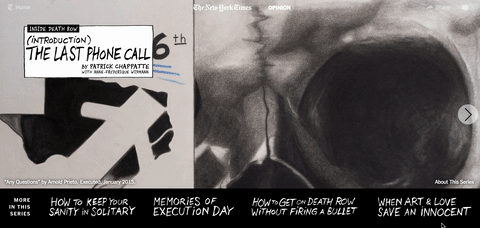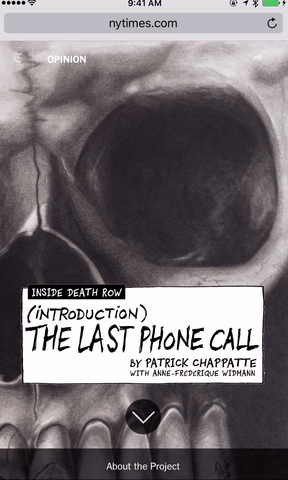It starts with Patrick Chappatte hunched over his phone at an event, talking with a death row inmate in Texas.
“Inside Death Row,” a five-part graphics journalism series from The New York Times’ Opinion section, takes readers on a journey with editorial cartoonist Chappatte and his wife, journalist Anne-Frédérique Widmann, as they approach a prison in Texas, staring up at a looming wall with slim rectangle windows.
The story follows them as they sit inside a caged room at San Quentin’s death row visiting room and into a cell in Arkansas.
“I found out very early that in that genre, in that form of subjective journalism, it is very effective to personalize the point of view,” Chappatte said. “It’s a way to take the reader by the hand. The reader comes along with you and experiences the same thing you are experiencing as a reporter.”
In “Inside Death Row,” Chappatte and Widmann bring readers into the lives of four prisoners. The series debuted online Thursday and the first part will publish in print on Sunday. It started as an art exhibition by Chappatte and Widmann. The original idea, Chappatte said, was to contribute to conversations about capital punishment using art with voices from outside and inside the prisons.
On Thursday, Chappatte was adapting the series for print. It’s also a different experience on mobile and desktop. Chappatte worked with Danny DeBelius, a designer and developer at the Times, to come up with the mobile version.
Here’s a GIF that shows how the intro to the series begins on desktop:

And here’s how it appears on mobile:

“The obvious challenge to start with is that Patrick draws these comics in this six cell, two row grid that is intended for a broadsheet,” DeBelius said. “It’s intended for the print product.”
His first challenge was to adapt one-, two- and six-cell grids to a portrait phone display. To take the challenge a step further, he zoomed in on many of the elements in a single panel, such as caption bubbles and text.
“That’s how we arrived at wanting a solution that would help pace the reader through the information,” he said.
Users can vertically swipe or tap to advance the story.
“With your little swipe, you are giving the rhythm of the story,” Chappatte said.
It’s also intentionally a vertical experience on mobile.
“I really don’t think that it’s a good idea to force people into changing the orientation of the device,” DeBelius said. “It seems like a very small thing, but I know in my own experience, it’s extremely frustrating.”
If users want to look at the project horizontally, they’ll have an experience closer to the desktop’s.
Chappatte previously told a friend that putting a story like this together and having it work on smartphones was just too complicated.
“So I need to reach back to my friend and tell him hey, look what they did,” he said.
Chappatte and Widmann have told the stories of death row inmates on stage, through video, art from the inmates, with live music and through interviews. They’re currently working on a documentary film, and there could be more episodes of this series.
“We’re really taking people along inside the prison,” Widmann said, “and then everyone can have their own conclusions.”







